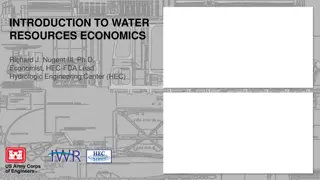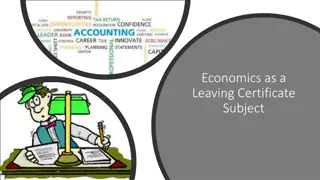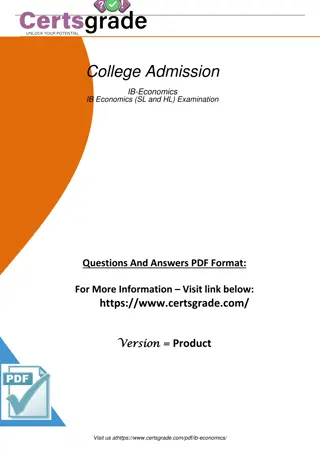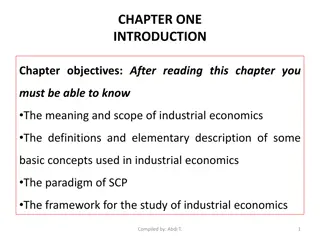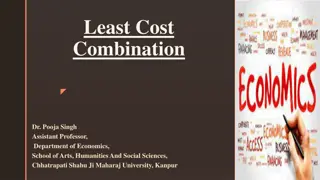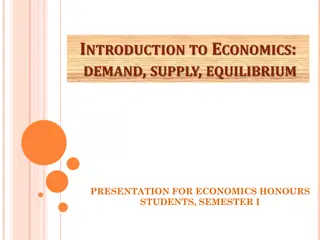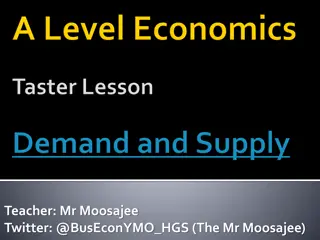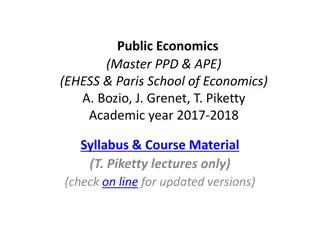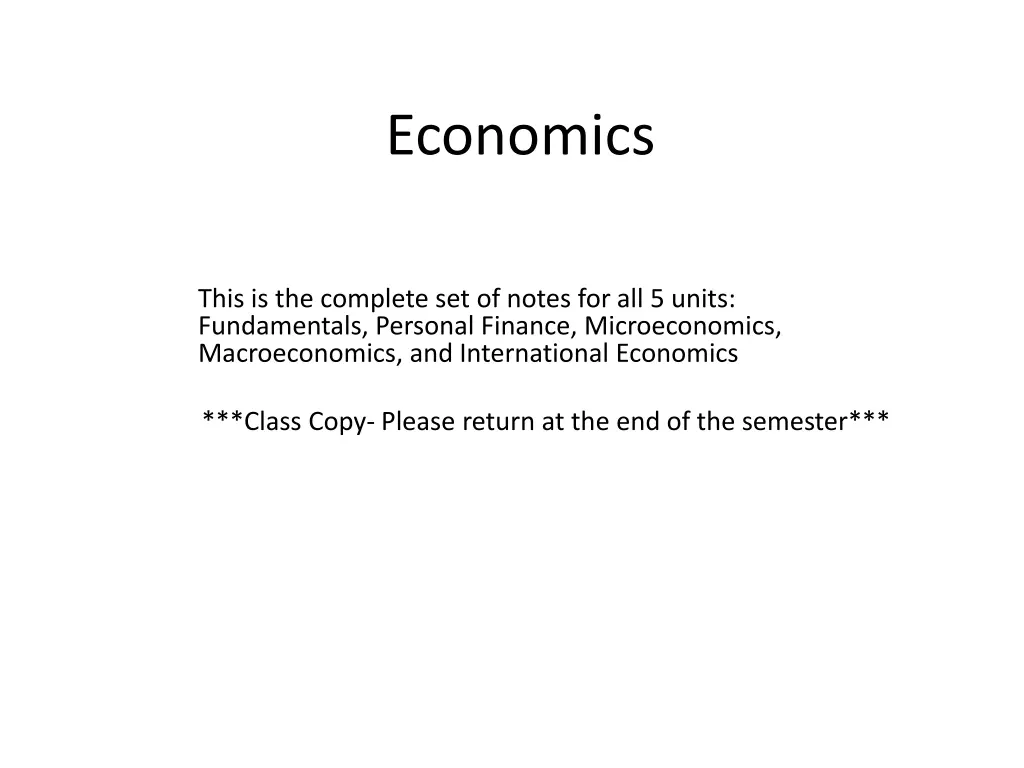
Complete Economics Notes: Fundamentals, Personal Finance, Microeconomics, Macroeconomics, International Economics
Dive into the world of economics with this comprehensive set of notes covering topics such as scarcity, choice, factors of production, resource allocation strategies, and more. Understand key terms, learn about wants versus needs, and explore how the factors of production earn money. Enhance your knowledge of economics across various units for a well-rounded understanding.
Download Presentation

Please find below an Image/Link to download the presentation.
The content on the website is provided AS IS for your information and personal use only. It may not be sold, licensed, or shared on other websites without obtaining consent from the author. If you encounter any issues during the download, it is possible that the publisher has removed the file from their server.
You are allowed to download the files provided on this website for personal or commercial use, subject to the condition that they are used lawfully. All files are the property of their respective owners.
The content on the website is provided AS IS for your information and personal use only. It may not be sold, licensed, or shared on other websites without obtaining consent from the author.
E N D
Presentation Transcript
Economics This is the complete set of notes for all 5 units: Fundamentals, Personal Finance, Microeconomics, Macroeconomics, and International Economics ***Class Copy- Please return at the end of the semester***
Key Terms: Fundamentals (Unit 1) Economics: is the study of how individuals, institutions, and society make optimal choices under conditions of scarcity. Scarcity: when unlimited wants exceed limited resources. Choice: to pick out by preference from what is available
Key Terms Wants: may be things people must have to live (shelter, food, or clothing) or simply goods and services one desires and would obtain if he/she could. Needs: shelter, food, and clothing Resources: are those things which humans can put to productive use( factors of production).
Factors of Production 1. Land: includes not only property on which a production plant is built, but all other natural resources. (land, forests, water resources, oil) 2. Labor: is the contribution of human workers to the production process. (school teachers, janitors)
Factors of Production 3. Capital: refers to all the structures and equipment involved in the manufacturing process. (machinery storage, transportation) 4. Entrepreneurship: is a specific form of labor. A risk-taker in search of profits who does something new with existing resources.
How the Factors of Production Earn Money WIRP 1. Wages (for labor) 2. Interest (for capital) 3. Rent (for land) 4. Profit (entrepreneurs)
Strategies for Allocating Scarce Resources Role of Price 1. Prices serve a vital role in the free market economy 2. Prices help move land, labor, and capital into the hands of Producers, and finished goods into the hands of buyers. 3. Prices create efficient resources allocation for producers and a language that both consumers and producers can us.
Strategies for Allocating Scarce Resources Prices provide a language for buyers and seller 1. Price as an incentive: prices communicate to both buyers sellers whether goods or services are scarce or easily available. Prices can encourage or discourage production. 2. Signals: a high price is a green light to tell producers to make more. A low price is a red light telling producers to make less. 3. Flexibility: in many markets, prices are much more flexible than production levels. They can be easily increased or decreased to solve problems of excess supply or excess demand.
Strategies for Allocating Scarce Resources Supply and Demand a. Supply: the amount of a product that would be offered for sale at all possible prices that could prevail in the market b. Demand: the relationship between the price of a good or service and the quantity of it that consumers are willing to buy at that price.
Strategies for Allocating Scarce Resources Government Regulation 1. Price ceiling: means that the price of a certain good or service is not allowed to rise above a certain level. 2. Price floor: means that a certain good or service is not allowed to drop below a certain price 3. Rationing: only allows citizens to purchase so much of a scarce good to make sure there is enough
The Decision-Making Model P.A.C.ED is the decision making model that helps you examine the problem you are trying to solve, come up with alternatives, evaluate those alternatives and come to a decision. The letters tell you the process P-Problem A-Alternatives C-Criteria E-Evaluation D-Decision
The Decision-Making Model Alternatives Trade-off: the alternative choice Opportunity cost: the next best alternative given up when individuals, businesses, and governments confront scarcity by making choices.
The Decision-Making Model Evaluation Marginal benefit: the extra benefit Marginal cost: the extra cost When marginal benefit is greater than the cost, he marginal benefit should be obtained. When the marginal benefit is less than the marginal cost, the desired good is not worth the cost and should not be obtained. Law of diminishing marginal utility: decreasing satisfaction or usefulness as additional units of a product are acquired.
The Production Possibility Curve 1. The production process takes inputs and uses them to produce outputs. Inputs include land, labor, capital, and entrepreneurs. 2. The PPF curve measures the maximum combination of two outputs that can be achieved from a given number of inputs. It demonstrates the trade-off among choices, given existing institutions, resources, and technologies.
The Production Possibility Curve 3. The curve slopes downward from left to right. This represents the opportunity cost because you always have to give up some product A to get more product B. 4. The curve bowed out to represent the principle of increasing marginal opportunity cost: in order to get more of something, one must give up increasing quantities of something else.
The Production Possibility Curve 5. Point A, B, and C represents efficiency: achieving as much output as possible from a given number of inputs. 6. Point Y represents an unattainable point at the moment because of limited resources or technology. 7. Point X represents an attainable point but undesirable.
Reasons for a shift in the PPF curve (Economic Growth or Loss) 1. Technology (Quality of Resources) 2. Land (Resources) 3. Population (Resources) 4. Education (Quality of Resources)
Key Concepts 1. Profit: the money made after producers have paid for all of their costs. 2. Productivity: the measure of the amount of output produced by a given amount of inputs in a specific period of time.
Key Concepts 3. Specialization: allows individuals, firms, regions, or nations to concentrate on a single activity or area of expertise. Example: peaches in Georgia, grapes in California 4. Division of labor: breaking productive tasks into smaller and more specialized acts. Example: the assembly line
Key Concepts 5. Voluntary exchange: is when individuals and businesses freely choose to exchange goods, services, and resource for something else of value.
4 Types of Economies Traditional Economy 1. Economic activity stems from the rituals, habits or customs. 2. Strengths: Everyone knows their role. There is little uncertainty about WHAT to produce, HOW to produce. All is based on customs and traditions. 3. Weaknesses: New ideas are discouraged. There is little variety of goods, services, and ideas about producing them. The tendency away from progress leads to lower standards of living in traditional systems.
4Types of Economies Command economy 1. The central authority or government, makes most of the economic decisions. 2. Strengths: Changes can be made quickly and efficiently, because the government has control of all resources and makes all decisions about WHAT, HOW and FOR WHOM to produce goods and services. 3. Weaknesses: This system provides few incentives for workers to give their best effort- workers have no say in what is produced and how it is produced (their jobs) and may have not interest in quality of their products. (PEOPLE DON T ENJOY BEING TOLD WHAT TO DO ALL THE TIME .) The government must have many workers to carry out it s work---to many people making decisions can slow the process and increase costs of production.
4 Types of Economies 1. Weaknesses Continued: o The wants and needs of the citizens sometimes go unheeded as the government makes decisions for all (THERE IS LITTLE VARIETY OF GOODS AND SERVICES) o This system is relatively inflexible and cannot react quickly to daily problems that arise in production. o New ideas rarely find their way into the economy. Entrepreneurship is squelched.
4 Types of Economies Market Economy 1. Define 2. Strengths: This system can adjust to change gradually. Government interference is low, giving consumers freedom to choose what they want to buy and producers freedom to choose what and how to produced goods.
4 Types of Economies 2. Strengths Continued: Decentralized decision making gives more people a voice in the way the economy runs. The variety of goods and services provided in a market economy is high, so consumers satisfaction is higher than in systems where there is little variety.
4 Types of Economies 3. Weaknesses : People who cannot work-because they are too old or young, to sick, or otherwise physically unable to do work are at a disadvantage, because this system rewards productive resources and does not protect non-productive resources. Without some government involvement, these people suffer.
4 Types of Economies 3. Weaknesses : Success relies on three conditions Competition-producers must be competing with one another to offer the best value for the cost Flexibility of resources- for example a worker must have the freedom to change jobs, if she is dissatisfied with her work. Access to information should be equal across the economy It is difficult for an economic system to guarantee that these conditions are met without government regulations.
4 Types of Economies Mixed Economy o An economy which has the characteristics of a market economy with some government intervention and regulation. o Because of this government interference, the United States is said to have a mixed market economy
4 Types of Economies 4. Traditional economy: an economy in which the allocation of resources and nearly all other economic activity stems from ritual, habit, or customs.
4 Roles of Government 1. Provide Public goods: products that are collectively consumed by everyone (parks) a. Goods: an item that is economically useful or satisfies an economic want. b. Services: work that is performed for someone (haircut) c. Private goods: product that is consumed by individuals
4 Roles of Government 2. Redistribution of income: is when the government takes money from citizens who have it (taxes) and gives it to citizens who don t (welfare) 3. Resolve market failures: in order to avoid an economic crisis, the government will, from time to time, jump in and interfere with the natural economic cycle. (government reg.) 4. Private property rights: include the ability to own one s property.
Common Ways the Government Tries to Regulate the Economy 1. Tariffs: a special tax place on products imported from another country. 2. Subsidies: a payment from the government to a business. 3. Federal reserve action: controls money supply 4. Environmental regulations ***Deregulation: when government stops or decreases regulation of an industry.
Productivity 1. Productivity: the rate at which goods and services are produced. A. Inputs: all the factors of production that go into producing a good or service. B. Outputs: is simply the amount of good or service produced. 33
Production Costs 1. Fixed costs: a cost that does not change, regardless of how much of a good is produced. Ex. rent and salaries 2. Variable costs: are costs that rise or fall depending on how much is produced. Ex. costs of materials, some labor costs. 3. Total cost: equals fixed costs plus variable costs 34
Investment Investment: using resources that could bring immediate benefits for the purpose of gaining greater benefits at a later time 35
Impact on Investment 1. Interest: money paid to an investor in exchange for the use of their money. 2. Capital investment: an investment in capital goods and human capital. a. Capital goods (Physical Capital): are those products used to make other goods or provide services. Example: an investment in technology, cell-phone will help society as a whole. b. Human capital: an investment in people. Example: college 3. Standard of living: quality of life based on ownership of necessities and luxuries that make life easier. 36
Personal Finance (Unit 2) Incentive: reward that a person is likely to receive if he or she behaves in a certain manner. A. Positive incentive: positive reward B. Negative incentive: negative reward
Banks, Credit Unions, and Savings and Loans 1. Commercial banks: financial institutions that receive deposits of money, extend credit, and provide loans. a. Interest charged: interest the bank charges them to borrow money. b. Interest earned: interest the bank pays them for the use of their money. 2. Credit unions: are cooperative associations that serve only their members. They offer checking and savings accounts, as well as grant loans. 3. Savings and loan associations: are saving institutions designed to aid home building.
Risk and Return 1. Return: refers to the eventual payoff of the investment. 2. Risk: refers to the chance that an investment might actually end up losing money rather than making money.
Savings and Investment Options 1.Stocks: are shares in a company that an individual/organization purchases giving that person/entity part ownership. 2.Bonds: loans to either a company or the government. 3.Mutual funds: pool money from a number of investors to buy a range of stocks.
Workers Earnings 1. Workers earnings: how much employers pay workers for their labor. 2. Potential earnings: how much money one is likely to make in the labor market due to their skills, training, and education.
3 Types of Taxes 1.Progressive tax: a tax that imposes a higher percentage of taxation on persons with high incomes than on those with low incomes. (Federal Income Tax) 2.Regressive tax: a tax that imposes a higher percentage rate of taxation on low incomes than on high incomes. (sales tax) 3.Proportional tax: a tax that imposes the same percentage of taxation on everyone, regardless of income. (F.I.C.A. Social Security and Medicare)
Credit and Interest 1. Credit: is an agreement under which a buyer receives goods or services at the present time in exchange for a promise to pay for them at a future time. 2. Interest: is the amount of money that a lender charges a borrower in exchange for the use of their money.
Interest 1. Credit cards: when you use a credit card you are borrowing the credit card issuers money as a loan that you will pay back with interest. 2. Debit cards: when you use a debit card you are using your own money, so you pay no interest.
Simple and Compound Interest 1. Simple interest: is a rate that is applied only to the value of the principal. (simple interest grows slowly) 2. Principal: is the amount of money that has been borrowed. 3. Compound interest: is interest applied to both the principal and the interest. (you pay interest on interest) (compound interest grows fast)
Simple Interest If they continued to receive 5% interest on the original $100 amount, over ten years the growth in their investment would look like this: Year 1: 5% of $100 = $5 + $100 = $105 Year 2: 5% of $100 = $5 + $105 = $110 Year 3: 5% of $100 = $5 + $110 = $115 Year 4: 5% of $100 = $5 + $115 = $120 Year 10: 5% of $100 = $5 + $145 = $150Year Compound Interest 1: 5% of $100 = $5 + $100 = $105 Year 2: 5% of $105 = $5.25 + $105 = $110.25 Year 3: 5% of $110.25 = $5.52 + $110.25 = $115.76 Year 4: 5% of $115.76 = $5.79 + $115.76 = $121.54 . Year 10: $162.89 Simple: $150 vs. Compound: $162.89
Credit Worthiness 1. Debt: is the amount of money that you owe on money that you have borrowed. 2. Credit score: is a number base on your history as a borrower. Bad debt damages your credit score. 3. Credit worthiness: when a lender uses your credit score to determine what type of loan you will receive. a. If your credit score is high, lenders will loan you money at a lower interest rate. (600 to 800) b. If your credit score is low, lenders will loan you money at a higher interest rate. (599 to 499)
Insurance Insurance: money paid to an insurance company for assurance that, if what they value is lost or damaged, the insurance company will pay for their loss.
5 Types of Insurance 1. Health/medical insurance: is meant to cover health and medical expenses. 2. Disability insurance: provides a policy- holder with income in the event that they become disabled and unable to work. 3. Liability insurance: pays if your are held financially liable (responsible) for an accident.


